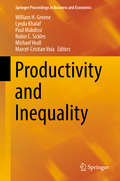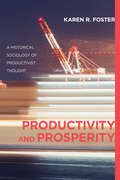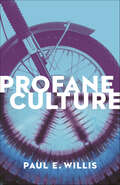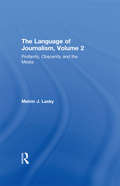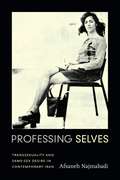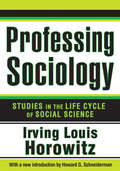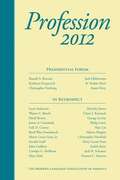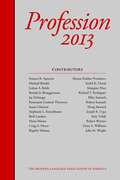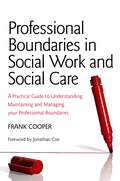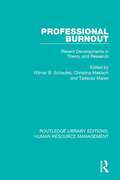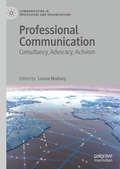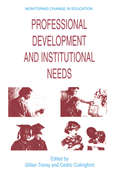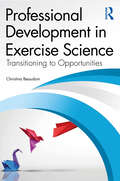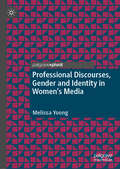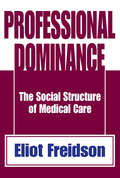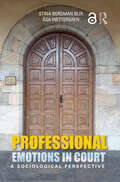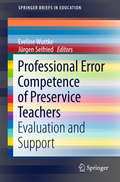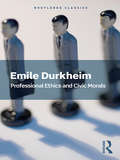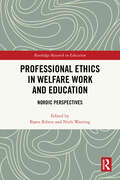- Table View
- List View
Productivity and Inequality (Springer Proceedings In Business And Economics)
by William H. Greene Lynda Khalaf Michael Veall Marcel-Cristian Voia Robin C. Sickles Paul MakdissiThe volume highlights the state-of-the-art knowledge (including data analysis) of productivity, inequality and efficiency analysis. It showcases a selection of the best papers from the 9th North American Productivity Workshop. These papers are relevant to academia, but also to public and private sectors in terms of the challenges that firms, financial institutions, governments, and individuals may face when dealing with economic and education related activities that lead to increase or decrease of productivity. The volume also aims to bring together ideas from different parts of the world about the challenges those local economies and institutions may face when changes in productivity are observed. These contributions focus on theoretical and empirical research in areas including productivity, production theory and efficiency measurement in economics, management science, operation research, public administration, and education. The North American Productivity Workshop (NAPW) brings together academic scholars and practitioners in the field of productivity and efficiency analysis from all over the world, and this proceedings volume is a reflection of this mission. The papers in this volume also address general topics as education, health, energy, finance, agriculture, transport, utilities, and economic development, among others. The editors are comprised of the 2016 local organizers, program committee members, and celebrated guest conference speakers.
Productivity and Prosperity: An Historical Sociology of Productivist Thought
by Karen R. FosterDespite Canada's economic success over the past thirty years, the country's ranking in productivity has continued to decline when compared to other industrialized nations. Economic experts and pundits repeatedly call for means of improving productivity, arguing that it is the lynchpin to prosperity. However, there is growing evidence to the contrary. In Productivity and Prosperity, Karen Foster zeroes in on the paradox of productivity: that it is the key to economic prosperity and yet its connection to well-being and median incomes has all but disappeared. Drawing together three case studies including the development of Statistics Canada, the National Productivity Council, and the evolution of the Atlantic Canada Opportunities Agency, Foster argues that there is a 'productivist regime' guiding policy development in Canada and abroad. By analyzing and critiquing the inherent assumptions of productivism the author destabilizes the myth that economic growth is essential for quality of life.
Produktiver Umgang mit Spannungsfeldern und Grenzen in der Projektarbeit: Handlungsempfehlungen aus der Praxis (essentials)
by Christian Bachmann Michael ZirklerProjektleitende erleben vielfältige Spannungsfelder in ihrer Arbeit und sind dabei besonders exponiert. Das Buch erklärt die verschiedenen Spannungsfelder, denen Projektverantwortliche ausgesetzt sind und zeigt, wie ein nachhaltiger Umgang über Grenzmanagement gelingen kann, damit die anspruchsvolle Aufgabe mit Freude, Erfolg und bleibender Gesundheit erledigt werden kann. Praktische Hinweise zur produktiven und nachhaltigen Gestaltung der Projektleitungsrolle werden aus Sicht der Praxis vorgestellt.
Produktivität im „Reich der Freiheit“: Freizeitbudgets im Alltag und im Alter
by Heiner MeulemannGewinnen mit der wachsenden Freizeit produktive auf Kosten konsumtiver Aktivitäten? Zeitbudgetbefragungen zeigen, wie sich mit der wachsenden Freizeit die Verteilung der Freizeit auf produktive und konsumtive Aktivitäten verändert – sowohl in der täglichen Freizeit aller wie mit dem Freizeitgewinn durch Alter und Ruhestand. Im Zeitbudget der gesamten deutschen Bevölkerung zwischen 2001 und 2012 und im Vergleich der Altersgruppen unter und über 65 Jahren wachsen produktive Freizeitaktivitäten nicht auf Kosten konsumtiver an, wohl aber im Vergleich von Erwerbstätigen und Rentnern.
Produktivität neu denken: Vom Trennungs- zum Vermittlungsbegriff
by Hannah SchragmannDer Begriff der Produktivität findet täglich Verwendung, um die eigene Leistung zu bewerten. Darin, so die These, zeigt sich ein problematisches Verhältnis zur eigenen Tätigkeit. Denn was bedeutet Produktivität? Die Autorin geht von dem antiken weiten Verständnis von Produktivität als generellem Wirkprinzip aus und zeigt, wie sich Vorstellungen in Bezug auf das, was als produktiv gilt, gewandelt haben. Heute dominiert das ökonomische Verständnis, das die Beziehung zwischen Input (hervorbringender Natur) und Output (hervorgebrachter Natur) quantifiziert. Produktiv ist der Mensch, wenn er viel schafft – und nicht, wenn er ‚sich hervorbringt‘. Die Autorin entwickelt einen neuen Produktivitätsbegriff, der die menschliche Fähigkeit zu produktiver Selbstwerdung ins Zentrum stellt. So entsteht auch ein neuer Blick auf (humanistisch) produktive Arbeit, der diese nicht an Effizienzmaximen, sondern der Beziehung des Subjekts zur Tätigkeit festmacht. Zugleich soll Systemproduktivität im Subjekt verwurzelt werden: Das (wirtschaftliche) System gilt nicht mehr als produktiv, wenn es kurzfristig Gewinne, sondern nur, wenn es langfristig Bedingungen für Individual(re)produktivität bereitstellt. Der Begriff der Produktivität wird so (wieder) als Vermittlungsbegriff fruchtbar gemacht.
Profane Culture: Updated Edition
by Paul E. WillisA classic of British cultural studies, Profane Culture takes the reader into the worlds of two important 1960s youth cultures—the motor-bike boys and the hippies. The motor-bike boys were working-class motorcyclists who listened to the early rock 'n' roll of the late 1950s. In contrast, the hippies were middle-class drug users with long hair and a love of progressive music. Both groups were involved in an unequal but heroic fight to produce meaning and their own cultural forms in the face of a larger society dominated by the capitalist media and commercialism. They were pioneers of cultural experimentation, the self-construction of identity, and the curating of the self, which, in different ways, have become so widespread today.In Profane Culture, Paul Willis develops an important and still very contemporary theory and methodology for understanding the constructions of lived and popular culture. His new preface discusses the ties between the cultural moment explored in the book and today.
Profanity, Obscenity and the Media
by Melvin J. LaskyThis is the second volume of Melvin J. Lasky's The Language of Journalism series, praised as a "brilliant" and "original" study in communications and contemporary language, and as "a joy to read." When it was first published, it broke ground in focusing on the comparative styles and prejudices of mainstream American and British newspapers, and in its trenchant analysis of their systematic debasement of language in the face of obligatory platitudes and compulsory euphemisms.Lasky documents the growing crisis affecting honest, thoughtful, and independent journalism in the Western world. He extends the scope of his first volume in the trilogy and deepens the interpretation. He also adds a personal touch of wit and anecdote, as one might expect from an experienced international journalist and historian. Lasky's examination of the use of formerly forbidden language is a triumph of sinuous semantics. In his incisive analysis, we see the tortuous struggle of a once Puritanized literary culture writhing to break free of censorship and self-censorship.This volume on the phenomenon of profanity adds another dimension to Lasky's thesis on mass culture's trivialization of real social and political phenomena. It also underscores our society's embrace of banality, in standardizing politically correct jargon and slang. Readers of the first volume will find here a new range of references to illuminate the detail of what our newspapers have been publishing.
Professing Selves: Transsexuality and Same-Sex Desire in Contemporary Iran
by Afsaneh NajmabadiSince the mid-1980s, the Islamic Republic of Iran has permitted, and partially subsidized, sex reassignment surgery. In Professing Selves, Afsaneh Najmabadi explores the meaning of transsexuality in contemporary Iran. Combining historical and ethnographic research, she describes how, in the postrevolutionary era, the domains of law, psychology and psychiatry, Islamic jurisprudence, and biomedicine became invested in distinguishing between the acceptable "true" transsexual and other categories of identification, notably the "true" homosexual, an unacceptable category of existence in Iran. Najmabadi argues that this collaboration among medical authorities, specialized clerics, and state officials--which made transsexuality a legally tolerated, if not exactly celebrated, category of being--grew out of Iran's particular experience of Islamicized modernity. Paradoxically, state regulation has produced new spaces for non-normative living in Iran, since determining who is genuinely "trans" depends largely on the stories that people choose to tell, on the selves that they profess.
Professing Sociology: Studies in the Life Cycle of Social Science
by Irving HorowitzProfessing Sociology was originally published at a time when sociology commanded widespread interest and public funding. Written by one of the leaders of "the new sociology" of the late sixties, this volume captures the nature and intensity of the field's intellectual foundations and scope. It reveals the field's post-World War II development as a scientific discipline and as a profession, and includes the author's most significant writings on critical trends shaping the field.Irving Louis Horowitz divides the life cycle of sociology into three main sections. The first deals with the inner life of sociology, covering basic theoretical issues uniting and dividing the profession. In a second section, Horowitz shows the institutions and sources from which the struggle of ideas is nourished. A third section shows how political life shapes the inner life of American sociology. Horowitz gives a great deal of attention to international social science, to the relationship of social science to public policy, and to federal projects and grant agencies and their effects on research.Irving Louis Horowitz was undoubtedly influential in shaping his field, and Professing Sociology offers valuable insights into how ideas become part of the fabric of professional life. As the new introduction by Howard G. Schneiderman shows, Professing Sociology provides a clear picture of sociology at the height of its importance.
Profession 2011 (Profession Ser.)
by The Modern Language Association of AmericaThis issue of Profession contains Sidonie Smith's introduction to her Presidential Forum (held at the 2011 MLA convention) and the essays of forum participants Hillary Chute, Marianne Hirsch, Leigh Gilmore, Craig Howes, Françoise Lionnet, Nancy K. Miller, David Palumbo-Liu, Brian Rotman, Leo Spitzer, Robert Warrior, and Gillian L. Whitlock. The issue also features a section on evaluating digital scholarship. Introduced by Susan Schreibman, Laura Mandell, and Stephen Olsen, the section includes essays by Steve Anderson, Kathleen Fitzpatrick, Jerome McGann, Tara McPherson, Bethany Nowviskie, and Geoffrey Rockwell. The issue's other essays are by Reed Way Dasenbrock, Gillian Gane, Laurie Grobman, Joyce Kinkead, David Porter, and Richard Yarborough. The issue concludes with two sets of MLA guidelines--on professional employment practices for non-tenure-track faculty members and on evaluating translations as scholarship--and a listing of reports, surveys, statements, and other resources recently added to the MLA Web site.
Profession 2012 (Profession Ser.)
by The Modern Language AssociationThis issue of Profession contains Russell A. Berman's introduction to his Presidential Forum, Language, Literature, Learning, held at the 2012 MLA convention, and the essays of the forum participants Kathleen Fitzpatrick, Christopher Freeburg, Jack Halberstam, B. Venkat Mani, and Imani Perry. To mark the journal's thirty-fifth anniversary, the issue also features a retrospective sampling of articles that illustrate the evolution of the profession and of the professional issues the journal has addressed since its inception in 1977. The retrospective section includes articles by Leon Anderson; Wayne C. Booth; Heidi Byrnes; James A. Castaeda; Erik D. Curren; Reed Way Dasenbrock; Henry Louis Gates, Jr.; Gerald Graff; John Guillory; Carolyn G. Heilbrun; Mara Holt; Dorothy James; Claire J. Kramsch; George Levine; Philip Lewis; Alan Liu; Helene Moglen; Christopher Newfield; Mary Louise Pratt; Judith Ryan; Jack H. Schuster; and Domna C. Stanton.
Profession 2013
by The Modern Language AssociationThis issue of Profession contains Michael Bérubé's introduction to his Presidential Forum, Avenues of Access, which was held at the 2013 MLA convention, and the essays of the forum participants: Joshua A. Boldt, Beth Landers, Maria Maisto, and Robert Samuels. The issue also features a section on a statistical study documenting the participation of people of color in humanities doctoral programs. Curated by the MLA Committee on the Literatures of People of Color in the United States and Canada, the section includes an introduction by Ifeoma Kiddoe Nwankwo and Richard T. Rodríguez; articles by Frances R. Aparicio, Robert Warrior, and Dana A. Williams; and a conclusion by Doug Steward. The issue's four other essays cover a variety of topics. Disability and access in higher education is the subject of a collaborative article by Brenda Jo Brueggemann, Jay Dolmage, Rosemarie Garland-Thomson, Susan Ghiaciuc, Stephanie L. Kerschbaum, Craig A. Meyer, Sushil K. Oswal, Margaret Price, Ellen Samuels, and Amy Vidali. Rogelio Miñana writes about a curricular experiment; superliteracy and doctoral programs are the focus of Joseph R. Urgo's article; and Julia M. Wright's topic is faculty governance.
Professional Burnout: Recent Developments in Theory and Research (Routledge Library Editions: Human Resource Management)
by Christina Maslach Tadeusz Marek Wilmar B. SchaufeliA rapidly growing number of people experience psychological strain at their workplace. In almost all industrialized countries, absenteeism and turnover rates increase, and an increasing amount of workers receive disablement benefits because of psychological problems. This book, first published in 1993, concentrates on a specific kind of occupational stress: burnout, the depletion of energy resources as a result of continuous emotional demands of the job. This volume presents theoretical perspectives that had been developed in the United States and Europe, discusses methodological issues, and examines organisational contexts. Written by an international group of leading scholars, this book will be of interest to students of both psychology and human resource management.
Professional Communication: Consultancy, Advocacy, Activism (Communicating in Professions and Organizations)
by Louise MullanyThis edited book presents contemporary empirical research investigating the use of language in professional settings, drawing on the contributions of a set of internationally-renowned authors. The book takes a critical approach to understanding professional communication in a range of fields and global contexts. Split into three parts, covering Business and Organisations, Healthcare, and Politics and Institutions, the contributors explore how and why academics engage in workplace research which takes the form of 'consultancy', 'advocacy' and 'activism'. In light of an ever-changing, ever-demanding global landscape, this volume offers new theoretical and methodological ways of conducting professional communication research with real-world impact. It will be of interest to linguistics and communication researchers and practitioners, particularly those working in sociolinguistics, discourse analysis, business communication, health communication, political communication, language and the law and organisational studies.
Professional Competition and Professional Power
by David Sugarman Yves DezalayExamines the ongoing efforts of lawyers and allied professionals to construct, police and redefine their boundaries. Focusing on the newly emerging large multinationals, it explores the relationship between professions, the economy and the state.
Professional Development and Institutional Needs (Monitoring Change in Education)
by Cedric Cullingford Gillian TroreyThe tension between institutional needs and those of the individual has rarely been higher. Increasing demands on institutions to deliver set targets and value for money whilst adhering to set expectations and external constraints has led to an erosion of the notion of staff development. This book looks at how the conflict between the two outlooks emerges and what can be done to overcome it. Based on empirical evidence, the authors reveal what is happening in a range of institutions and explore the tensions between the personal needs of the individual and the demands of managers. They examine the reasons behind the conflict and discuss what measures can be taken to overcome it. The book will provide a central text on an important but relatively neglected subject of interest to all engaged in the profession.
Professional Development in Exercise Science: Transitioning to Opportunities
by Christina BeaudoinProfessional Development in Exercise Science prepares students and complements their extensive academic foundation for a career or professional opportunity within the field of exercise science. This textbook provides students with the knowledge and skills to bridge gaps more effectively between their academic preparation and their chosen profession. There is an extensive array of career and professional options for students within exercise science, and this textbook will help develop a deeper understanding of how to navigate the personal and professional world confidently. The textbook integrates insights from communication, business, leadership, psychology, and exercise science to explore the dynamic interplay between the personal and the professional realms, providing a deeper understanding of the interconnections between the two.This new text, the first of its kind in the field of exercise science, is invaluable for all exercise science and kinesiology students. Students aspiring to careers within the discipline and related sub-disciplines, as well as those exploring postgraduate studies, will gain insights into the critical intersections between personal growth and professional achievement.
Professional Discourses, Gender and Identity in Women's Media
by Melissa YoongThis book examines the professional discourses produced in women’s media in Malaysia and the subject positions that they make available for career women. Drawing on feminist critical discourse analysis, critical stylistics and feminist conversation analysis, it identifies a range of gendered discourses around employment and motherhood that are underpinned by postfeminism and neoliberal feminism. Through close linguistic analysis of magazine and newspaper articles and radio talk, the study reveals that these discourses substitute balance, individual success, self-transformation and positive feelings for structural change, and entrench the very issues hindering gender workplace equality. Chapters discuss topics such as sexism, work-family balance, extensive and intensive mothering, breadwinning, gender stereotypes, beauty work, ‘synthetic sisterhood’, media practices and gender equality policies. This book will be of great interest to students and scholars of language and gender, discourse analysis, and media, communication and cultural studies as well as policy-makers, media practitioners and feminist activists.
Professional Dominance: The Social Structure of Medical Care
by Eliot FreidsonIn the United States today we are confronted by a number of serious social problems, not the least of which concern the character of our basic human services. In each of the broad public domains of welfare, education, law, and health there are crises of public confidence. Each in its own way is failing to accomplish its essential mission of alleviating material deprivation, instructing the young, controlling and righting criminal and civil wrongs, and healing the sick. The poor, the student, the offender and the victim, the sick-all have in some way protested the failure of the institutions responsible for them. And these protests occur at a time when the human services are absorbing an increasingly massive amount of money and manpower. Awareness of that crisis intensified in the second half of the twentieth century. Increasing energy has been invested in research designed to determine what can be done. Each of the human services has long had its own research tradition, but during the sixties each has also made a concerted effort to mobilize and use the skills of such comparatively new disciplines as sociology. Owing to these new demands, sociology itself has grown. The hitherto obscure specialties of the sociology of law and medicine and the established specialties of criminology and educational sociology have taken on new vigor. In applying themselves the task of studying the human services, however, these segments of sociology have had to choose between two different strategies. Rather than dealing with the details of the human services for their own sake-and this lack of detail in a characteristic limitation of the second approach-this book shall instead attempt to stand outside the system in order to delineate one of its critical assumptions and a strategic feature of its basic structure. This book deals with the concept of profession, for the concept rests on assumptions about how services to laymen should be controlled and is realized by a special kind of
Professional Emotions in Court: A Sociological Perspective
by Åsa Wettergren Stina Bergman BlixProfessional Emotions in Court examines the paramount role of emotions in the legal professions and in the functioning of the democratic judicial system. Based on extensive interview and observation data in Sweden, the authors highlight the silenced background emotions and the tacitly habituated emotion management in the daily work at courts and prosecution offices. Following participants ‘backstage’ – whether at the office or at lunch – in order to observe preparations for and reflections on the performance in court itself, this book sheds light on the emotionality of courtroom interactions, such as professional collaboration, negotiations, and challenges, with the analysis of micro-interactions being situated in the broader structural regime of the legal system – the emotive-cognitive judicial frame – throughout. A demonstration of the false dichotomy between emotion and reason that lies behind the assumption of a judicial system that operates rationally and without emotion, Professional Emotions in Court reveals how this assumption shapes professionals’ perceptions and performance of their work, but hampers emotional reflexivity, and questions whether the judicial system might gain in legitimacy if the role of emotional processes were recognized and reflected upon.
Professional Empowerment in the Software Industry through Experience-Driven Shared Tacit Knowledge: A Case Study from China
by Hui Chen Miguel Baptista NunesThis book addresses the identification and classification of knowledge acquired through experience that results from engaging in professional activities within the software industry. As a result of this study, the book presents an ontology of such professional activities that require and enable the acquisition of experience and that, in turn, are the basis for tacit knowledge creation. The rationale behind the creation of such an ontology was based on the need to externalize this tacit knowledge and then record such externalizations so that these can be shared and disseminated within and across organizations. The book discusses the very concise manner in which experienced software development practitioners in China understand the nature and value of experience in the SW industry, effectively communicate with other stakeholders in the software development process, are able and motivated to actively engage with continuous professional development, are able to share knowledge with peers and the profession at large, and effectively work on projects and exhibit a sound professional attitude both internally to their own company and externally to customers, partners, and even competitors. The book also discusses the ontology and the qualitative process that are generated by bridging two extremely topical aspects of practice in the software industry, namely, employability skills and competencies. The book is of interest to academics in the areas of knowledge management and information systems, as well as human resources practitioners concerned with selection and development and knowledge and information professionals in software organizations.
Professional Error Competence of Preservice Teachers
by Jürgen Seifried Eveline WuttkeThis book discusses competence, teacher competence, and professional error competence of teachers, and emphasizes the need for a training programme that supports the latter. The book starts out by presenting results from previous studies that underline the necessity to train professional error competence of teachers, especially in the field of accounting. The studies analysed include research in the field of accounting, and on the efficacy of teacher training. Next, considerations on training programmes are presented. From these analyses, a training programme was designed to support professional error competence in accounting. This training programme aims for increased knowledge about students' errors (content knowledge) and offers strategies to handle these errors (pedagogical content knowledge). Both are central facets of professional error competence. The book describes the development, characteristics, implementation, and evaluation of this programme. It details the test platform that was developed and used for the assessment of professional error competence, and critically discusses the results from the evaluation of the training programme from various perspectives. The current discussion on teacher training and expertise is influenced by empirical results obtained in international large-scale studies such as PISA and TIMSS. The findings of the studies underpin the discussion on teaching quality and teachers' professional competences. The key issue is that teacher competence has an impact on teaching quality and this, in turn, influences students' achievements. International comparative studies reveal that teachers often lack central competence facets, and therefore it is assumed that standard teacher training programmes may fail to successfully prepare student teachers for their tasks. Therefore, customized training programmes are currently being discussed. Their focus is mostly on pedagogical content knowledge and classroom practices, because these competence facets are essential for teaching quality.
Professional Ethics and Civic Morals (Routledge Classics)
by Emile DurkheimÉmile Durkheim is one of the founding fathers of sociology and Professional Ethics and Civic Morals is one of his most neglected yet insightful works. Durkheim's view that the instability of industrial society was connected to the decline of religion and his characterization of the state as the ultimate moral force in society reveal his lifelong engagement with the relationship between the individual and society. In Professional Ethics and Civic Morals Durkheim poses a major question: given the negative social consequences of unfettered markets, which caused what he termed ‘anomie’, how is the state to reconcile morality with the market? Durkheim argues that the answer is to be found in the evolution of a civil religion, in the form of professional codes and civic values, which would counteract the effects of individualism, just as guilds had regulated medieval economic life. Arguing that the state has a vital role to play in moral life and that morals are at bottom social facts – a controversial position which drew considerable criticism – Durkheim also argues that the state had a duty to protect the rights of the individual, via a form of cosmopolitan patriotism. Durkheim also articulates a highly original and critical interpretation of the rules around property and inheritance – a perspective which resonates with debates about inequality and the redistribution of wealth today. Included in this Routledge Classics edition is a new introduction by Bryan S.Turner, placing Durkheim in contemporary context and outlining the key tenets of Professional Ethics and Civic Morals.
Professional Ethics in Welfare Work and Education: Nordic Perspectives (Routledge Research in Education)
by Bjørn Ribers Niels WarringFundamentally concerning the relationship and dynamics between education, professionalism and ethical awareness, this interdisciplinary, edited volume showcases novel research perspectives on professional ethics in education, practice, and the work life of welfare professionals in the Nordic countries.Contextualising the term ‘welfare professions’ as the collective definition of teachers, early childhood educators, social educators, social workers and nurses in the Nordic countries, the book chiefly concerns their ability to navigate within the complex political and institutional frameworks that surround their working environments. Chapters position their competence to act with strong critical, ethical awareness and integrity as a key tenet of a well-functioning education system, and provide research-based perspectives and reflections on how the dichotomy between ethical standards and realities of practice can lead to ethical pressure and moral distress. With contributions from Denmark and the Nordic countries, as well as Canada and the US, the book offers empirical and theoretical perspectives into the relationship between education, professionalism and ethical awareness, and is supported with empirical examples and research-based case studies. Ultimately, the book showcases and promotes research aimed at strengthening professionalism based on critical, innovative and practice-focused education.This enlightening book will be essential reading for global academics, researchers and postgraduate students in the fields of pedagogy, professional development, the sociology of education, and education ethics more broadly. Those involved with issues of welfare in society, working life research, policy and professional values will also find the volume of use.
